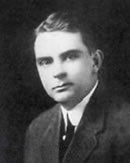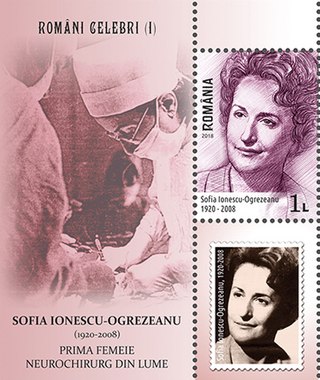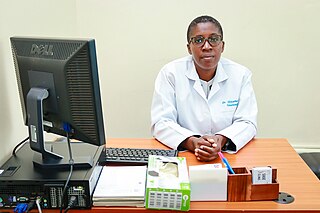Related Research Articles

Neurosurgery or neurological surgery, known in common parlance as brain surgery, is the medical specialty concerned with the surgical treatment of disorders which affect any portion of the nervous system including the brain, spinal cord and peripheral nervous system.
The Stanford University School of Medicine is the medical school of Stanford University and is located in Stanford, California, United States. It traces its roots to the Medical Department of the University of the Pacific, founded in San Francisco in 1858. This medical institution, then called Cooper Medical College, was acquired by Stanford in 1908. The medical school moved to the Stanford campus near Palo Alto, California, in 1959.

Walter Edward Dandy was an American neurosurgeon and scientist. He is considered one of the founding fathers of neurosurgery, along with Victor Horsley (1857–1916) and Harvey Cushing (1869–1939). Dandy is credited with numerous neurosurgical discoveries and innovations, including the description of the circulation of cerebrospinal fluid in the brain, surgical treatment of hydrocephalus, the invention of air ventriculography and pneumoencephalography, the description of brain endoscopy, the establishment of the first intensive care unit, and the first clipping of an intracranial aneurysm, which marked the birth of cerebrovascular neurosurgery.
UCL Medical School is the medical school of University College London (UCL) and is located in London, United Kingdom. The school provides a wide range of undergraduate and postgraduate medical education programmes and also has a medical education research unit and an education consultancy unit. It is internationally renowned and is currently ranked 6th in the world by the QS World University Rankings for Medicine 2023.
John R. Adler is an American neurosurgeon and medical device entrepreneur.

Emily Dunning Barringer was the world's first female ambulance surgeon and the first woman to secure a surgical residency.

Sofia Ionescu-Ogrezeanu was the first female neurosurgeon in the world.
T. S. Kanaka or Thanjavur Santhanakrishna Kanaka, also known as Tanjore Santhana Krishna Kanaka, was Asia's first female neurosurgeon and one of the world's first few female neurosurgeons. She was the first neurosurgeon in India to perform chronic electrode implants in the brain, having been also the first to perform deep brain stimulation as early as in 1975. She pioneered functional neurosurgery in the 1960s and 1970s along with Prof. Balasubramaniam, Prof. S. Kalyanaraman; and received recognition for her research and contributions to the field of stereotactic surgery. She is also a recipient of the Lifetime Achievement Award of Madras Neuro Trust.

Alexa Irene Canady is a retired American medical doctor specializing in pediatric neurosurgery. She was born in Lansing, Michigan and earned both her bachelors and medical degree from the University of Michigan. After completing her residency at the University of Minnesota in 1981, she became the first black woman to become a neurosurgeon. This came after Ruth Kerr Jakoby became the first American woman to be board certified in neurosurgery in 1961.
Yoko Kato is a Japanese neurosurgeon. She is professor and chair of the Department of Neurosurgery at Fujita Health University. She was the first woman in Japan to be promoted to full professor of neurosurgery.
Benjy Frances Brooks was an American pediatric surgeon affiliated with several hospitals in Houston. She was the first woman in the surgery department at Harvard Medical School and the first woman to become a pediatric surgeon in the state of Texas. She founded the pediatric surgery division at the University of Texas Health Science Center at Houston. Brooks actively conducted research throughout her career in addition to working as a pediatric surgeon.

Sylvia Shitsama Nyamweya, is a Kenyan consultant neurosurgeon at the Kenyatta National Referral Hospital. She is the first female neurosurgeon in Kenya and one of a handful of female neurosurgeons in the country.

Diana Jean Kinloch Beck was the first female English neurosurgeon. She established the neurosurgery service at Middlesex Hospital in London, where she gained a public profile for operating on A. A. Milne.

Philip Ransom Conley was an American athlete. He competed in the men's javelin throw at the 1956 Summer Olympics. His wife was Frances K. Conley, the first official female winner of the Bay to Breakers and an acclaimed neurosurgeon. He graduated from California Institute of Technology with a B.S. in Mechanical Engineering and earned an MBA from Harvard Business School.

Odette Harris is a professor of neurosurgery at Stanford University and the Director of the Brain Injury Program for the Stanford University School of Medicine. She is the Deputy Chief of Staff, Rehabilitation at the VA Palo Alto Health Care System.
Linda M. Liau is an American neurosurgeon, neuroscientist, and the W. Eugene Stern Chair of the Department of Neurosurgery at the David Geffen School of Medicine at UCLA. Liau was elected to the Society of Neurological Surgeons in 2013 and the National Academy of Medicine in 2018. She has published over 230 research articles and a textbook, Brain Tumor Immunotherapy. She served as editor-in-chief of the Journal of Neuro-Oncology from 2007 to 2017.

Dorothy KlenkeNash was an American surgeon based in Pittsburgh, Pennsylvania. She was considered the first American woman to become a neurosurgeon, and the only American woman neurosurgeon from 1928 to 1960.

Claire Karekezi is a Rwandan neurosurgeon at the Rwanda Military Hospital in Kigali, Rwanda. As the first female neurosurgeon in Rwanda, and one of the eight Rwandan neurosurgeons serving a population of 14 million, Karekezi serves as an advocate for women in neurosurgery. She has become an inspiration for young people pursuing neurosurgery, particularly young women.

Sandi Lam is a Canadian pediatric neurosurgeon and is known for her research in minimally invasive endoscopic hemispherectomy for patients with epilepsy. Lam is the Vice Chair for Pediatric Neurological Surgery at Northwestern University and the Division Chief of Pediatric Neurosurgery at Lurie Children's Hospital. She has spent her career advancing pediatric brain surgery capabilities globally through her work in Kenya performing surgeries as well as training and mentoring local residents and fellows.
Juliet Sekabunga Nalwanga is a physician from Uganda, who is the country's first female neurosurgeon. As of 2021, she was one of only thirteen neurosurgeons in Uganda. As of 2018, she was employed by Mulago National Referral Hospital in Kampala.
References
- 1 2 3 Jacoby, Susan (April 26, 1998). "Hospital Harassment: A woman neurosurgeon writes about sexism among doctors". The New York Times . Retrieved January 3, 2020.
- ↑ "Spotlight on WINS: Frances K. Conley, MD". Women in Neurosurgery. 1998. Archived from the original on February 16, 2012. Retrieved January 3, 2012.
- 1 2 3 4 "Changing the Face of Medicine: Dr. Frances K. Conley". U.S. National Library of Medicine, National Institutes of Health. Retrieved January 3, 2012.
- ↑ Conley, Frances (1998). Walking Out on the Boys . New York: Farrar, Straus and Giroux.
- ↑ Conley, Frances (June 17, 1991). "Sexism in the Workplace". Los Angeles Times .